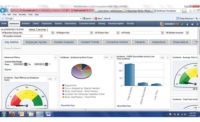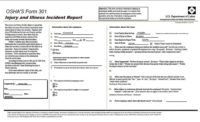Health, safety, and industrial hygiene professionals are continually confronted with the challenge to gather, review, and act wisely based on various types of data. In their efforts to improve safety, organizations should examine a variety of health and safety metrics. Safety management software is one tool available that can help safety professionals to consolidate this data and improve the safety decision-making process.
This article explores how safety management software can assist in the data collection and data analysis needs of the environmental, health, and safety (EHS) manager.
Data collection, data analysis and decision-making
EHS professionals need to review and analyze data in multiple areas to achieve regulatory compliance and improve safe practices in the workplace. Most organizations keep track of this data in some way, from pen and pencil to spreadsheets to software systems. Safety management software that is affordable, easy to use, and can track your safety data needs is available in the marketplace for organizations from large to small and everywhere in between.
EHS professionals can use a wide variety of data sets to understand safety throughout their organizations. Common safety data sets include: incidents, inspections, training, and action-item follow up. Other areas might include behavior-based safety, near misses, hazard tracking, industrial hygiene monitoring and job safety analysis.
Incident data
Most companies track incident and injury data, focusing most often on recordkeeping when an employee injury occurs. Many organizations are required to track and record employee injuries on the appropriate OSHA recordkeeping logs, the 300, 301, and 300A. These logs record the who, what, where, and how of the injury/illness for each incident that has occurred and also includes details about any missed days from work or restricted duty imposed on the injured employee.
Organizations with multiple locations need to generate OSHA logs for each location. In addition, almost all U.S. states also require that the employer file a First Report of Injury for any workers’ compensation claim. Safety management software can take incident data and automatically generate OSHA recordkeeping and state First Report of Injury forms, allowing organizations to improve regulatory compliance and to save time and effort.
Safety management software can also allow companies to push deeper into their incident data to discover powerful analytics in minutes. Need to know the most often occurring type of your employee injuries? What is an incident’s root cause? Is there a workforce group that has more incidents than others? A shift or time of day that is more dangerous? These are all common questions that incident safety data can help your organization to answer.
Inspection data
Most organizations conduct a wide variety of inspections on an ongoing basis. Oil and gas companies, for example, may conduct daily rig inspections, and construction companies may conduct daily site inspections. EHS professionals, front-line employees or supervisors may conduct these daily inspections. EHS professionals generally also conduct more in-depth weekly, monthly or annual inspections.
Many companies often find it difficult to perform trend analysis based on the results of their inspections and struggle to ensure that all open items from these inspections are closed out in a timely manner. Safety management software can take the inspection checklist items results and automatically provide detailed trend analysis on the areas of deficiencies or areas of compliances across a single job site or multiple locations or sites. Safety management software can also alert and notify key managers and employees of open inspection action items that require follow up.
Advances in mobile technology make it easier than ever for organizations to conduct inspections in the field without using paper. With safety management software, key team members can conduct inspections on a wide variety of mobile devices including smartphones and tablets. For organizations or team members without Internet access, an offline mobile application can allow team members to conduct inspections in the field and synch the inspection data to the software when Internet access is available. This process allows for real-time analytics and no duplication of data entry.
Training data
Most organizations conduct extensive training of employees, supervisors, and managers. Employees require an ever-increasing array of training in a wide variety of areas including environmental, health and safety issues to perform their job in a safe manner.
For example, OSHA requires employees be trained on emergency action plans and emergency evacuation training. Much of the OSHA training regulations also require refresher training on an annual basis or sooner if conditions or job positions change. Safety and training managers need to be able to determine what employees are overdue or upcoming for required (re-)training to ensure that all employees are in compliance. Safety and training managers also need to be aware of employees who change positions and/or work on a seasonal basis so that training can be tracked and adjusted to meet their needs.
Safety management software can easily track employee training, including conducted training and required re-training. Email notifications can alert employees, supervisors, managers, and safety professionals of upcoming or overdue training. Scheduling tools also make it easy to schedule training for groups or individuals. With the appropriate permissions, EHS managers and other managers can view an employee’s entire training history as well as their incident/injury history. Trend reports allow key managers to quickly view overdue training or employees who are not in compliance with required training.
Conclusion
With safety management software, safety professionals can easily track and identify trends in their companies’ reporting, giving them increased visibility into their business’ operations.
There are many benefits to using safety management software to record, track, and analyze your company’s safety data. Implementing safety management software can save employees time and energy by allowing them to automatically generate required reports and collect data more efficiently than a manual process.
For large worksites, corporate sites, or mobile workforces, safety software can also promote consistency in recordkeeping and reporting and the forms for reporting incidents, hazards, corrective actions, etc., can be customized to better suit your company’s needs and standardized throughout your organization. In addition, using safety management software will allow all groups within your company to report on common data elements and develop common safety metrics for the entire organization.
In conclusion, safety management software can offer a wide variety of tools and options to allow EHS professionals to use data and data analytics to improve the safety of the workplace.




